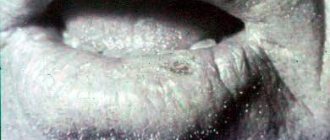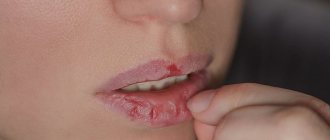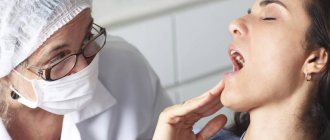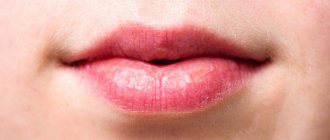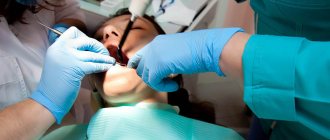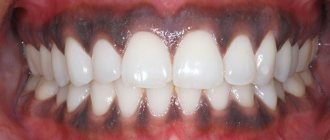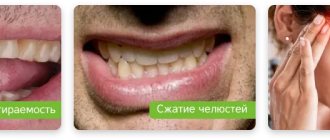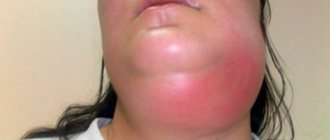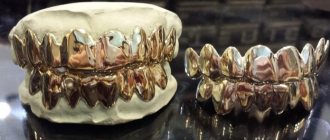Dermatovenerologist
Khasanova
Alina Rashidovna
9 years experience
Make an appointment
Patients often consult a doctor complaining of inflammation in the red border or mucous membrane of the lips. In most cases, a specialist diagnoses “cheilitis”. This is the name for tissue inflammation, which manifests itself in the form of redness, peeling, the appearance of purulent crusts and weeping ulcers. Any attempt to open the mouth when eating or communicating causes sharp pain associated with tissue damage. Without proper treatment, the disease persists for a long time, causing the patient a lot of physical and aesthetic inconvenience. For young people, the prognosis after clinical treatment of cheilitis is completely favorable, but older patients may encounter its complications in the form of leukoplakia and the onset of the oncological process.
Reasons for development
In the clinical practice of most specialists, there are cases where cheilitis on the lips developed on its own or was a side effect of a serious disease of the internal organs or damage to the mucous membrane. Among the most likely causes of the development of the disease are:
- inflammation of the mucous membrane with dermatoses, erythematoses or lichen planus;
- infectious diseases: syphilis, tuberculosis, etc.;
- psoriasis and other skin problems.
Among the unfavorable external factors, it is worth noting an excessive amount of ultraviolet radiation, strong wind, flows of cold or hot air from climate control equipment or ventilation in industrial premises. Signs of cheilitis are often observed in people who work in open areas in direct sunlight.
A separate group includes manifestations of allergic cheilitis, which developed after contact of the lip mucosa with aggressive chemicals or prolonged exposure to ultraviolet radiation. Sometimes doctors observe the clinical picture of secondary cheilitis, when the development of the disease is caused by eczema, neuritis of the facial nerve, pathologies of the muscles and tissues of the facial part of the skull.
Causes
The main reason for the development of this disease is old age. It is in old age that the immune defense weakens, pathological processes begin to form in the body, internal organs fail, and metabolism is disrupted. Because of these changes, the external defense also suffers and the epithelial layer weakens.
In old age, a person has few healthy teeth left; many have to be removed, which inevitably leads to the need to wear dentures. And since the majority of elderly people in our country are not well-off enough for treatment in paid clinics, they have to turn to state-owned clinics for the manufacture of prostheses, where the quality of the source material and the final product suffers significantly.
As a result, a complex of influencing factors, namely malnutrition of the skin of the lips, vitamin deficiencies, constant traumatic effects of low-quality prosthesis, as well as natural factors and injuries, lead to the formation of erosions on the lips.
Symptoms and signs depending on the type of cheilitis
The accepted classification of cheilitis makes it possible to clearly establish the type and causes of the disease, as well as to identify the characteristic signs of the pathological process:
- Exfoliative cheilitis is localized on the red border of the lips. It has a clear gender link: it occurs more often in women. The main symptom is peeling of the lips due to neurological disorders: stress, depression, anxiety. Often the inflammatory process develops against the background of hyperthyroidism, or intense activity of the thyroid gland. The danger of exfoliative cheilitis is its ability to be inherited as a genetically fixed change in the body’s immune system.
A feature of exfoliative cheilitis is localization only on the red border of the lips, while the mucous membrane and skin around the mouth remain intact. In most cases, only part of the border is affected, while areas at the corners of the mouth usually retain their appearance. If a patient has dry skin, he often complains of tightness of the lips, the appearance of scales, and a burning sensation. It is almost impossible to completely cure exfoliative cheilitis. The disease proceeds along a sinusoid, sometimes exacerbating, sometimes disappearing under the influence of medications and external factors. Without medical supervision and if you refuse to take a course of treatment, large bleeding crusts form on the lips, which cause discomfort during conversation and eating.
- Glandular cheilitis develops against the background of pathological proliferation of the salivary glands. A humid environment creates favorable conditions for pathogenic microorganisms, as a result of which the mucous membrane becomes easily infected. If the pathology of the salivary glands is congenital, the probability of developing glandular cheilitis is 100%. The risk group also includes patients with dental problems: untreated caries, periodontitis, tartar, etc.
In some cases, glandular cheilitis develops as a result of damage from waste products and the breakdown of pathogenic microorganisms. The disease is more often diagnosed in patients over 30 years of age and is localized on the lower lip. Primary symptoms are dry lips and the appearance of painful cracks. Usually these symptoms are ignored, and attempts are made to combat them with local cosmetic products. Without treatment, the problem worsens: erosions and bleeding wounds appear at the site of cracks. Involuntary licking of dry lips aggravates the pathological process, which leads to their further dryness.
- Contact allergic cheilitis is caused by exposure to an external allergen. This could be the chemical composition of lipstick, microorganisms on the surface of pencils or pens, which the patient is accustomed to often holding in his teeth during work or creative activities. Cheilitis is considered an occupational disease among musicians who are forced to hold the mouthpieces of instruments in their mouths for a long time. The symptoms of this type of pathology are quite common. Patients complain of itching, swelling, burning and inflammation of the lips. After prolonged contact with the allergen, blisters appear on the skin, the rupture of which opens small ulcers and erosions. In the chronic stage, the disease makes itself felt only with minor itching and peeling.
- Meteorological or actinic cheilitis is a reaction to weather conditions. For a sensitive organism, radiation, wind, cold or solar radiation are equally dangerous, provoking the appearance of characteristic symptoms: burning and itching, large crusts and erosion of the mucous membrane. With prolonged exposure to unfavorable climatic factors, the formation of small bubbles with liquid contents is possible. The dry form of cheilitis is considered the most dangerous for patients. Its first symptoms in the form of itching and burning are harmless. However, with prolonged development and lack of treatment, malignancy is possible - the degeneration of affected cells into a malignant formation.
- Atopic cheilitis is a type of skin disease: atopic dermatitis and neurodermatitis. The disease develops against the background of an allergic predisposition of the body, which reacts to cosmetics, perfumes, food and exposure to pathogenic bacteria. In addition to the usual symptoms, there is dryness and damage to the skin in the corners of the mouth, and intense peeling of the face.
- Hypovitaminous cheilitis develops against the background of a lack of B vitamins in the body. Patients usually complain of dryness and burning of the tongue and lips. Vertical cracks and small peeling scales are visible on the skin. The tongue increases in size, and teeth marks become visible on it.
Are you experiencing symptoms of cheilitis?
Only a doctor can accurately diagnose the disease. Don't delay your consultation - call
Treatment
In the advanced stage, Manganotti cheilitis is very difficult to treat with medications. However, if it is detected in the early stages, the prognosis for the patient is favorable. If you notice typical symptoms of this type of cheilitis, contact your dentist. Perhaps he will refer you for additional consultation with an oral and maxillofacial surgeon to eliminate factors traumatic to the lip.
Treatment of the disease begins with thorough sanitation of the oral cavity. In parallel with the treatment, the doctor prescribes the patient a gentle diet, consisting of fresh and lightly salted foods, rich in vitamins and minerals. Being in the open sun, much less smoking, is strictly contraindicated for such patients.
Treatment of Manganotti cheilitis consists of a course of taking multivitamins, theonicol and methyluracil, as well as an oil solution of vitamin A. The course of treatment usually lasts at least a month. It is recommended to constantly lubricate the lips themselves with retinol acetate or sea buckthorn oil. For more serious injuries, the doctor may prescribe corticosteroid ointments or even surgical removal of the inflammation. If cancer cells are detected in a biosample, surgery is an emergency measure to prevent further spread of the tumor.
Treatment of various types of cheilitis
The course is developed taking into account the type of diagnosed disease and the general condition of the body.
- For exfoliative cheilitis, additional consultations with a neurologist and neuropsychiatrist are recommended. The patient is prescribed a course of sedatives. Effective methods of local treatment include laser therapy, ultrasound or radiation therapy, and the use of moisturizing cosmetic creams and ointments. According to indications, hormonal medications and vitamin complexes are prescribed.
- Glandular cheilitis is removed with anti-inflammatory ointments. Local treatment consists of cauterization or desquamation of enlarged salivary glands, and during the rehabilitation period, the use of drugs to eliminate dryness or excess moisture of the mucous membrane.
- When treating atopic cheilitis, the goal is to eliminate any irritating factors. The local course is based on the use of anti-inflammatory and anti-allergic drugs in the form of external ointments. Patients are also recommended to have a hypoallergenic diet that excludes the consumption of fish, citrus fruits, spicy foods and alcohol.
- For meteorological cheilitis, treatment tactics include taking vitamin preparations, using local healing agents and ointments with a high UV filter.
Timely initiation of treatment and the patient completing its full course guarantees relief from the unpleasant symptoms of cheilitis with a long-term effect.
Diagnostics
The diagnosis of precancerous Manganotti cheilitis is usually made based on an external examination of the affected area and questioning the patient about the nature of the disease. In case of difficulties that may arise due to the similarity of the manifestations of this type of cheilitis with erosive and ulcerative forms of other diseases (herpes, leukoplakia, lupus erythematosus, lichen planus), analysis of scrapings from the damaged area of the lip will help. In addition, histological examination makes it possible to timely recognize the formation of cancer cells.
Etiology and pathogenesis of glandular cheilitis
Primary glandular cheilitis is a disease that many authors associate with a congenital anomaly of the salivary glands. Clinically, this anomaly manifests itself mainly after the end of puberty, after 20 years. The salivary glands located in the Klein zone, under the influence of various factors, hypertrophy and begin to produce saliva more intensively. Such factors include dental pathology, periodontal disease, pathology of the gums and dentition.
A hypothesis is put forward about a possible family, i.e. hereditary nature of the disease. A number of authors believe that a psychogenic factor plays a major role in the development of glandular cheilitis, confirming this assumption with good therapeutic results after psychotherapy.
The development of secondary glandular cheilitis is apparently due to the fact that the inflammatory infiltrate, characteristic of the underlying disease, irritates the glandular tissue and causes its hyperplasia and hyperfunction. The possibility of secondary glandular cheilitis confirms the point of view of a number of authors about the presence of heterotypic salivary glands in many healthy individuals. However, hyperplasia of glandular tissue with subsequent hyperfunction develops only in some people.
Prevention
In order to avoid encountering this unpleasant disease, patients at risk are recommended to:
- be examined by a dentist at least once every six months and promptly remove sharp edges of teeth, tartar, and damaged dental crowns that injure the lip;
- dentures should be made only from high-quality materials to suit the individual characteristics of the patient’s jaw apparatus;
- give up bad habits that destroy your health;
- do not stay in the sun for a long time, use protective equipment, including oil-based lipstick;
- pay attention to and begin treatment of chronic diseases of the gastrointestinal tract, endocrine system, internal organs;
Follow a diet that excludes salty, spicy, sour and spicy foods, as well as very hot foods and drinks.
Cheilitis
Cheilitis is an inflammatory process that affects the red border, mucous membrane and skin of the lips. It is manifested by swelling, redness, peeling of the lips, the appearance of bleeding ulcers, purulent crusts, burning and pain when opening the mouth and eating. Often the disease has a long-term recurrent nature. In young people, the course is more favorable, self-healing is possible. In old age there is a risk of leukoplakia and malignancy. Symptoms
There are several main diseases that provoke the development of cheilitis:
- allergies and dermatitis;
- tuberculosis;
- lichen;
- syphilis;
- psoriasis;
- eczema;
- ichthyosis;
- gastrointestinal diseases
- endocrine disorders;
- cancer.
Cheilitis has fairly simple symptoms:
- the presence of swelling of the lips, cracks on them and in the corners;
- swelling, dryness, peeling and burning on the lips;
- pronounced red border of the lips;
- pus and plaques;
- crusts and blisters on the lips.
Treatment
Treatment of exfoliative form
Treatment of exfoliative cheilitis is based on the impact on the psycho-emotional sphere. For this purpose, a neurologist or psychoneurologist prescribes sedatives, tranquilizers, and conducts psychotherapy.
Consultation with an endocrinologist and, if necessary, prescription of appropriate treatment is indicated.
Locally - successful use of laser therapy, ultrasound administration of various hormonal agents, Bucca therapy (radiation therapy).
To lubricate the lips, use hygienic lipstick. The use of vitamins C and B is effective.
To increase the body's reactivity, the use of drugs such as pyrogenal, prodigiosan, and autohemotherapy is recommended.
The use of immunocorrective drugs in complex treatment is effective. The treatment lasts 1-2 months, the prognosis is favorable.
Treatment of glandular cheilitis
In the treatment of glandular cheilitis, anti-inflammatory ointments are used (tetracycline, erythromycin, as well as flucinar and sinalar, oxolinic ointment, etc.). However, the most justified method is electrocoagulation of hypertrophied salivary glands or surgical removal of them.
Laser ablation using a surgical laser has been successful. For the purpose of prevention, sanitation of the oral cavity, elimination of dryness, weeping lips, normalization of the microbial landscape of the oral cavity and medical examination of patients are necessary.
Treatment of atopic cheilitis
In the treatment of atopic cheilitis, the identification and elimination of the irritant is of primary importance.
Ointments containing hormones that have antiallergic, antipruritic and anti-inflammatory effects (flucinar, prednisolone, fluorocort and other ointments) are used locally.
In addition, antiallergic therapy is carried out, Tavegil, Fenkorol, Claritin or other drugs are prescribed orally.
Substances that cause sensitization are excluded from the diet: caviar, chocolate, strawberries, citrus fruits and other fruits, as well as hot and spicy foods.
Treatment of meteorological form
Treatment of meteorological cheilitis involves, first of all, stopping the adverse effects of solar radiation or other meteorological factors.
Ointments with hormones (hydrocortisone, prednisolone, etc.) are used locally. Use protective creams against ultraviolet radiation. Vitamins of group B, PP, etc. are prescribed internally.
Treatment of macrocheilitis
In the treatment of macrocheilitis, the main role belongs to a combination of immunocorrective, desensitizing and antiviral therapy.
Assign
- hormones (dexamethasone),
- oxytetracycline,
- antiallergic drugs - tavegil, suprastin.
- vitamins C, B, PP.
- immunocorrectors - lykopid, etc.
- antiviral - bonafton, acyclovir, Zovirax, leukinferon.
The use of laser therapy on the lips and areas affected by neuritis of the facial nerve has a certain effect.
In persistent forms, during remission, stimulating therapy is carried out with pyrogenal, prodigiosan and other drugs.
For neuritis, physical factors, Bernard currents, ultrasound, etc. are used. Good results have been obtained from electrophoresis of heparin ointment or its application to the lip along with dimexide.
When hypersensitivity to bacterial allergens is detected, specific hyposensitization with bacterial allergens is used.
For cosmetic purposes, surgical excision of part of the lip is used, but this does not prevent recurrence. Recently, reports have appeared on the effective use of hirudotherapy (medicinal leeches).
Treatment of candidiasis cheilitis
In case of candidiasis, antifungal drugs in the form of ointments (clotrimazole) or antibiotic solutions (for example, nystatin or natamycin) are prescribed. Antiseptics (chlorhexidine, hexetidine) are also used. At the same time, activities aimed at strengthening the immune system are carried out.
